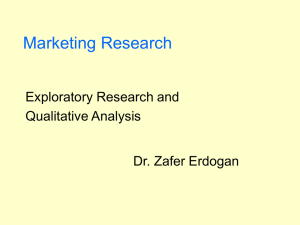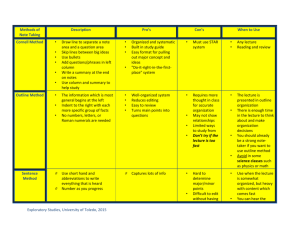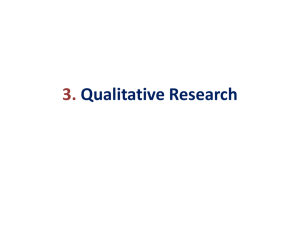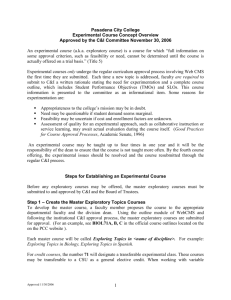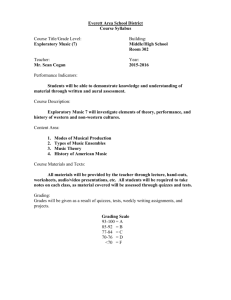Business Research Methods William G. Zikmund
advertisement
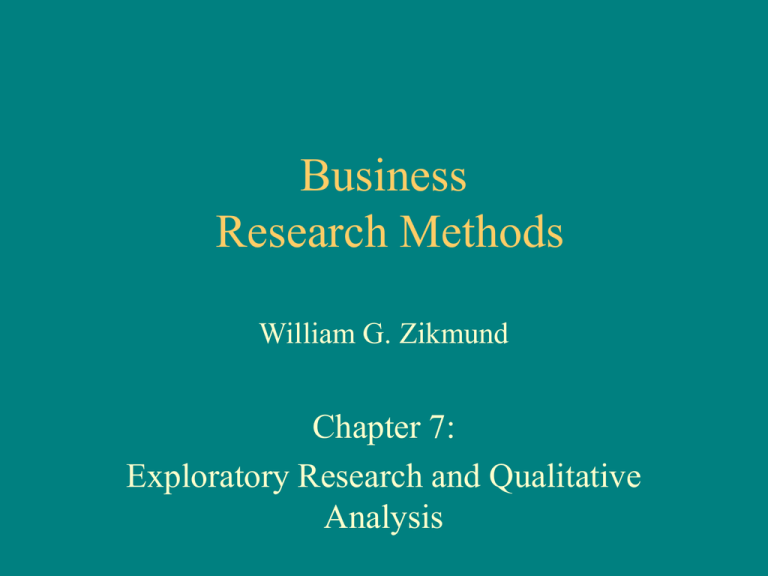
Business Research Methods William G. Zikmund Chapter 7: Exploratory Research and Qualitative Analysis Qualitative versus Quantitative Research • Purpose – Exploratory versus descriptive and conclusive • Small versus large samples • Broad range of questioning versus structured questions • Subjective interpretation versus statistical analysis Defining Problem Results in Clear Cut Research Objectives Symptom Detection Analysis of the Situation Problem Definition Statement of Research Objectives Exploratory Research (Optional) Exploratory research • Secondary data • Experience survey • Pilot studies Exploratory Research • Initial research conducted to clarify and define the nature of a problem • Does not provide conclusive evidence • Subsequent research expected What is Exploratory Research? QUANTITATIVE DATA QUALITATIVE DATA Why Conduct Exploratory Research? Diagnose a situation Screening of alternatives Discover new ideas Concept Testing • Exploratory research procedure that tests some sort of stimulus as a proxy for an idea about a new, revised, or repositioned product Categories of Exploratory Research • • • • Experience surveys Secondary data analysis Case studies Pilot studies Experience Surveys • Ask knowledgeable individuals about a particular research problem – most are quite willing “If you wish to know the road up the mountain, you must ask the man who goes back and forth on it.” - Zenrinkusi Secondary Data Analysis • Data collected for a purpose other than the project at hand • Economical • Quick source for background information Case Study Method • Intensely investigates one or a few situations similar to the problem • Investigate in depth • Careful study • May require cooperation Pilot Study • A collective term • Any small scale exploratory study that uses sampling • But does not apply rigorous standards Pilot Studies • Focus Group Interviews • Projective Techniques • In-Depth Interviews Projective Techniques • • • • • • Word association tests Sentence completion method Third-person technique Role playing T.A.T. Picture frustration version of T.A.T. “A man is least himself when he talks in his own person; when given a mask he will tell the truth.” --Oscar Wilde Word Association • Subject is presented with a list of words • Asked to respond with first word that comes to mind Word Association Examples • GREEN • Money • Lawn • Eggs and Ham Word Association Examples • CHEESE • Kraft • Cheddar • Goat Sentence Completion People who drink beer are ______________________ A man who drinks light beer is ___________________ Imported beer is most liked by ___________________ A woman will drink beer when____________________ Thematic Apperception Test T.A.T. Focus Group Interviews • • • • Unstructured Free flowing Group interview Start with broad topic and focus in on specific issues Group Composition • 6 to 10 people • Relatively homogeneous • Similar lifestyles and experiences Outline for a Focus Group • • • • Establish a rapport Begin with broad topic Focus in on specific topic Generate discussion and interaction The Moderator • Develops rapport helps people relax • Interacts • Listens to what people have to say • Everyone gets a chance to speak The Focus Group Moderator • Maintains loose control and focuses discussion • Stimulates spontaneous responses Advantages of Online Focus Groups • Fast • Inexpensive • Bring together many participants from wide-spread geographical areas • Respondent anonymity • Transcript automatically recorded Disadvantages of Online Focus Groups • Less group interaction • Absence of tactile stimulation • Absence of facial expression and body language • Moderator’s job is different Streaming Media
